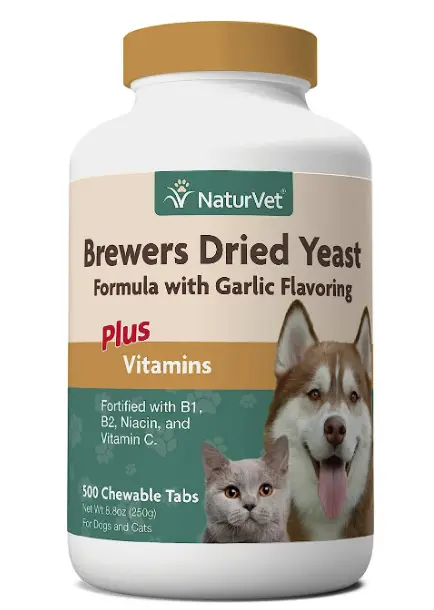There are several natural ingredients that pet parents have tried to help prevent fleas from infesting or biting their dogs. Brewers yeast is a major player when it comes to natural and holistic medicine for dogs.
As pet owners become aware of some of the side effects associated with preventative medicines they tend to search for natural and more holistic options. If an owner has a dog that develops allergies to these medications or they have exhibited signs of seizures pet parents may seek alternative routes of preventing ectoparasite and Brewer’s yeast is an easy go-to for many.

What is Brewer’s yeast?
Brewers yeast is a unicellular fungus in the species known as Saccharomyces cerevisiae. It is actually a remnant of the beer production process but it does not contain any alcohol.
In people, brewer’s yeast has been used as a supplement to help boost energy, enhance the immune system, and increase protein. However, in dogs, it is commonly used as a natural flea repellent.
It is an ingredient in many over-the-counter supplements for dogs and has been shown to help regulate blood sugar, be a good source of vitamin B, and has been shown to improve skin and coat health. It is also known for its flea-repellent capabilities.

How does brewer’s yeast work to repel fleas on dogs?
Brewer’s yeast has a number of compounds in it including sulfur which fleas don’t care for. The yeast sometimes produces sulfite which is an antioxidant.
Many pet owners rave about how Brewer’s yeast helped their pup get rid of fleas but there is actually little scientific evidence to back these claims up.
In a recent study, it was shown that brewer’s yeast (active and inactive) was not successful in repelling or killing fleas in twenty dogs. The researchers gave the dogs 14 grams of Brewer’s yeast for seven weeks and noticed no statistical difference between the control group and the study dogs.
However, they did notice a difference between dogs receiving active and those receiving inactive yeast.
How do I feed my dog Brewer’s yeast?
You can purchase Brewer’s yeast for dogs over the counter. It is available in tablet and powder form.

Always use the dried or inactive form and never give your dog the active form of Brewer’s yeast.
If you decide to forgo over-the-counter tablets or powders that give you appropriate doses for your dog’s size speak with a veterinary nutritionist about how much your individual dog should get.
As a general rule, most pet parents give about half a teaspoon for small dogs and 1 teaspoon for larger dogs over 30 pounds.
Like many natural formulas, you will have to wait a few days of administering before it takes effect and it may work on each dog differently.
What can you use to repel fleas naturally if Brewer’s yeast isn’t working?

There is an entire article about natural flea repellents that you can safely try for your dog, but one thing you can do is combine Brewer’s yeast with other forms of natural flea repellents.
If you have started using Brewer’s yeast and would like to continue to do so consider combining the product with a natural topical treatment like apple cider vinegar, diatomaceous earth, or if your dog is able to take an over-the-counter prescription preventative that is always an option as well.
Which dogs should not get Brewer’s yeast?
- Dogs with chronic diseases: Don’t give your dog with a chronic disease Brewer’s yeast before speaking with your vet about doing so. Brewer’s yeast can interact with some medications so it is best to make sure this is not going to be the case for your pup.
- Immunocompromised pets: If your dog has an autoimmune disease refrain from using Brewer’s yeast in their daily meals
- Obese dogs: Keep in mind that Brewer’s yeast is fairly high in calories when feeding so you may want to refrain or decrease the dose if your dog is obese
- Yeast infections: If your dog is prone to yeast infections you may want to hold off on giving them Brewer’s yeast
- Dogs with bowel diseases: Speak with your vet before giving your dog that has bowel disease like colitis or IBD Brewer’s yeast
Keep these things in mind when feeding your dog Brewer’s yeast
Brewers yeast can cause digestive issues
Brewer’s yeast has caused GI issues in some dogs such as excessive gas being the number one symptom, nausea, excess salivation, vomiting, bloat, and diarrhea. If you notice your dog has started to have a reaction to the yeast discontinue use and seek veterinary care immediately as your dog may be in a significant amount of pain.
Dogs can develop allergies to Brewer’s yeast
Dogs can develop allergies to Brewer’s yeast, like any other food and this may exhibit differently for each dog, some dogs may develop itchy skin while others have ear infections (or both). Keep a close eye on your pup when feeding Brewer’s yeast so you can watch for any signs of intolerance or allergic reaction.
Yeast infections
While many pet owners that have fed Brewer’s yeast in the past attribute it to their dog forming a yeast infection this is typically not true and it is caused by something else.
High in calories
Brewer’s yeast is high in calories so it is important to measure carefully and give the appropriate dose
It has individual results
Every dog is different and what works for some may not work for all, therefore it is beneficial to keep an eye on your dog’s flea population after application.
References
Failure of brewer’s yeast as a repellent to fleas on dogs (PubMed)


























































































































I’m really loving the theme/design of your site. Do you ever run into any browser compatibility issues? A few of my blog visitors have complained about my website not operating correctly in Explorer but looks great in Safari. Do you have any recommendations to help fix this issue?